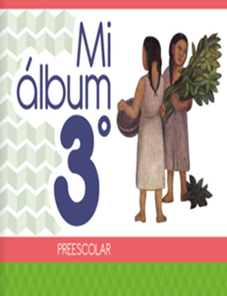Ayudemos a Pedro
Ayudemos a Pedro
Aprendizaje esperado: participa en la formulación de preguntas.
Énfasis: formula preguntas sobre objetos del aula.
¿Qué vamos a aprender?
Formularás preguntas sobre objetos que encuentras en el aula.

¿Qué hacemos?
As you can see, there is an image of a teddy bear and of different colors. They are to review what you learned the previous session; and that involves colors. / Como puedes observar, hay una imagen de oso de peluche y de diferentes colores. Son para repasar lo que aprendiste la sesión anterior; y que involucra los colores.
Next, look at the pictures of school supplies that you already know. You must answer the question, what color are the objects and point to the teddy bear that corresponds to that color. / A continuación, observa las imágenes de útiles escolares que tú ya conoces. Debes contestar la pregunta, ¿De qué color son los objetos? Señala el oso de peluche que corresponda a ese color.
Do you remember how you ask about the color of an object? / ¿Te acuerdas cómo preguntas por el color de un objeto?
The question is: What color is it? If it’s just one object, and What color are they? if they are many objects. / La pregunta es, ¿De qué color es? si es solo un objeto, y ¿De qué color son? si son varios objetos.
What color is the notebook? / ¿De qué color es el cuaderno?
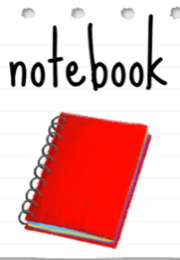
It is red. Can you point out the red Teddy Bear? / Es roja. ¿Puedes señalar el oso de peluche rojo?
What color is the pencil? / ¿De qué color es la lapicera?
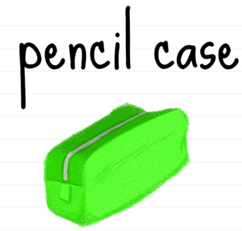
It is green. Point to the green Teddy Bear. / Es verde. Señala el oso de peluche verde.
What color are the colors? / ¿De color son los colores?
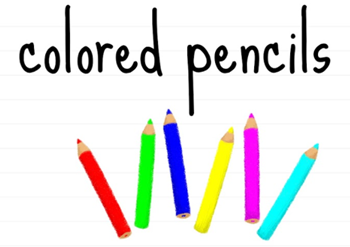
They are of many colors so you can point out all the teddy bears. / Son de muchos colores por lo que puedes señalar todos los osos de peluches.
Activity 1 / Actividad 1
En la siguiente actividad: Ayuda a Pedro a plantear la pregunta correcta respecto a los objetos que veas.
Pedro is in the living room watching the English sessions of Aprende en Casa III, but his school objects are on the floor. / Pedro está en la sala viendo las sesiones de inglés de Aprende en Casa III, pero sus objetos escolares están en el piso.

You help Pedro to group the objects? / Ayudas a Pedro a agrupar los objetos.
That way he can know how many school objects he has. / Así él puede saber cuántos objetos escolares tiene.
We will ask the number of the objects he has. Do you know how we ask that? / Cuantos objetos tiene, ¿Te acuerdas cómo preguntar eso?
It is used: How many, how many objects does it have? / Se usa, ¿Cuantas, cuantos objetos tiene?
Read the question and circle the number of objects we have. / Lee la pregunta y encierra en un círculo, el número de objetos que hay.
The question is: How many books are there? Can you count them for me, please? / La pregunta es: ¿Cuantos libros hay?

Activity 2 / Actividad 2
La siguiente actividad consiste en completar los patrones que estén incompletos.
Do you remember what a pattern is It is when you put objects, numbers, or words that follow a specific order, like a model you can repeat a lot of times.? / ¿Recuerdas qué es un patrón? Es cuando ordenas objetos, número o palabras en un orden específico, como un modelo que puedes repetir muchas veces.
Can you give an example? / ¿Puedes poner un ejemplo?
For example: apple- apple- orange. Apple-apple–orange. / Por ejemplo: manzana-manzana-naranja. Manzana-manzana-naranja.
Yellow-green-yellow. Yellow-green-yellow. Amaríllo- verde- amarillo, amaríllo- verde- amarillo.
Now guess which object is next in the following patterns. / Ahora adivina qué objeto es el siguiente en los siguientes patrones.
The pattern is one red Teddy Bear, a red number eight, and another red Teddy bear. / El patrón es un oso de peluche rojo, un número ocho rojo y otro de peluche rojo.
What object would f follow the pattern? It would be another red number eight / ¿Qué objeto continuaría el patrón? Sería otro número rojo.
The next pattern. / El siguiente patrón.
It is one school bag, then two school bags and another school bag. / Es una mochila, luego dos mochilas y otra mochila sola.
To follow the pattern, we need to put another school bag. / Para seguir el patrón, necesitamos una mochila más.
The next pattern begins with number seven, then number five and finally number seven again. To follow the pattern, we would put number five again. / El siguiente patrón comienza con el número siete, luego el número cinco y finalmente el número siete nuevamente. Para seguir el patrón volveríamos a poner el número cinco.
Activity 3 / Actividad 3
Revisa las palabras interrogativas.
Let’ s review the Wh questions. Do you remember them / Vamos a revisar las palabras interrogativas, ¿Las recuerdas?
What, where, who, when, how many / Qué, dónde, quién, cuándo, cuántos o cuántas.
Here, we have some questions or sentences and you are going to underline only the correct answer. / Aquí tenemos algunas preguntas u oraciones y tú vas a subrayar sólo la respuesta correcta.
The question is: What color is it? / La pregunta es: ¿De qué color es?
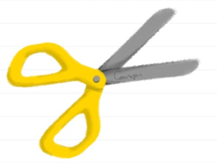
The possible answers are: yellow or nine. / Las posibles respuestas son: Amarillo o nueve.
Nine is a color? / ¿Nueve es un color?
Yellow is a color, so we underline yellow, please. / El amarillo es un color, por lo tanto, subrayamos amarillo.
Next question: How many rulers are there? / La siguiente pregunta: ¿Cuántas reglas hay?

The possible answers are: ruler or five. / Las posibles respuestas son: regla o cinco.
Ruler is a number? / ¿Regla es un número?
If the question is how many, then the answer is a number. It would be: five. / Si la pregunta es cuántas, entonces la respuesta es un número. Sería cinco.
Last question what is it? / Última pregunta. ¿Qué es?

Possible answers are: red or notebook. / Las posibles respuestas son: rojo o cuaderno.
The correct answer is notebook. / La respuesta correcta es “cuaderno”.
Very good! If the question begins with “what”, then the answer would be an object. / ¡Muy bien! Si la pregunta empieza con “qué”, entonces la respuesta será un objeto.
Now that you finished this activity about identifying the correct answers, it’s time to play with them. / Ahora que ya has realizado este ejercicio de identificar la respuesta correcta, es momento de jugar con ellas.
Con ayuda de unos dados identifica preguntas.
Make the following this dice. On each face, place a question. / Realiza el siguiente este dado. En cada cara coloca una pregunta.
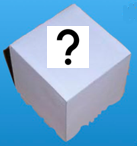
Draw your dice on a sheet of paper. / Dibuja tu dado en una hoja de papel.
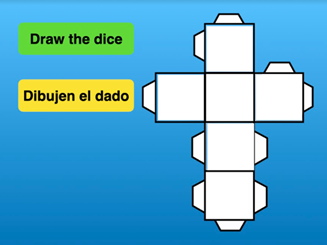
Write the questions or make the drawings. / Escribe tus preguntas o realiza tus dibujos.

With the help of whoever accompanies you, cut the banks. / Con la ayuda de quien te acompaña, corta las orillas.

Paste the corners. / Pega las esquinas.
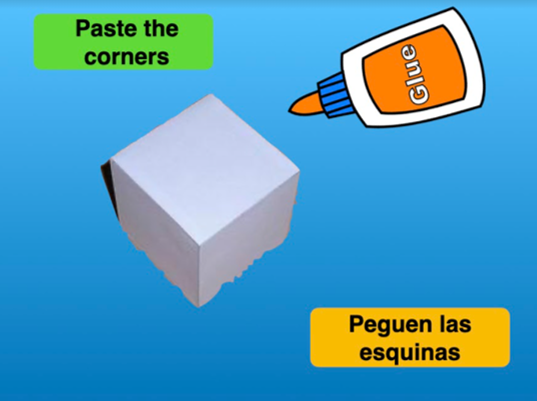
Enjoy playing! / ¡Disfruta jugando!
In this session, you learned how you can ask questions about school supplies. You reviewed the objects you already know and learned new things about them. / En esta sesión aprendiste cómo puedes hacer preguntas acerca de útiles escolares. Revisaste los objetos que ya conocías y aprendiste cosas nuevas sobre ellos.
Don’ t forget to share what you learned with your teacher and family. / No olvides compartir lo que aprendiste con tu maestra o maestro y con tu familia.
Si te es posible consulta otros libros y comenta el tema de hoy con tu familia.
Si tienes dudas o necesitas ayuda para realizar las actividades propuestas o alguna sugerencia y quieren compartirlas con nosotros pueden enviarlas al correo aprende_en_casa@nube.sep.gob.mx
Si quieres practicar más puedes visitar la página: http://proni.sep.gob.mx/
¡Buen trabajo!
Gracias por tu esfuerzo.
* Este material es elaborado por la Secretaría de Educación Pública y actualizado por la Subsecretaría de Educación Básica, a través de la Estrategia Aprende en Casa.
Para saber más:
Lecturas
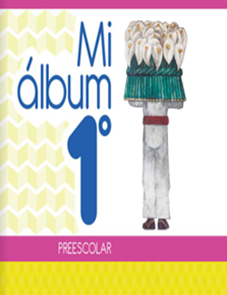
https://libros.conaliteg.gob.mx/20/K1MAA.htm
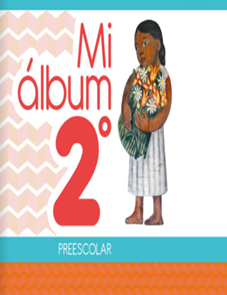
https://libros.conaliteg.gob.mx/20/K2MAA.htm
